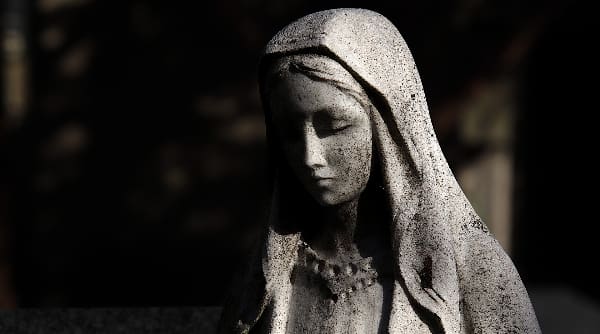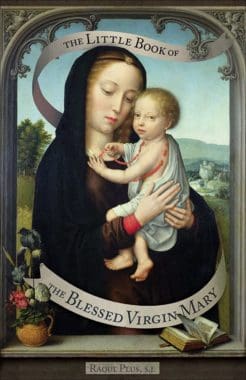There is no doubt that Mary’s influence extends to every grace. By the very fact that she is the Mother of God, she is the Mother of the Author of grace and, consequently, the Mother of all grace without exception.
Strictly speaking, can we say that all grace comes to us through Mary? Unhesitatingly we answer yes.
A very fundamental reason underlies this belief: a reason, at once simple and sublime, whose profound beauty does not astonish us, now that we are enlightened on the doctrine of the Mystical Body of Christ.
Two facts are certain: Mary is a mother. She is the Mother of the whole Christ. That is basic, for from this proposition, we can deduce the twofold truth: that Mary has something to do with all the graces that come to us and that nothing comes to us except through Mary.
The explanation is simple: Christ cannot be divided.
She whose mission it is to form Christ cannot isolate the Head from the members, nor form the Head and forget the members. It was Mary’s role to give birth to Christ and to care for Him. That was her duty toward her Firstborn; it is likewise her duty toward us, her second-born.
Ask any mother if the work of training and caring for a child is not one of constant details. If the mother knows her duty — and who would know it more splendidly and accomplish it with more love and delicacy than Mary — does she leave to chance the least of these details? Does she omit, under pretense of being interested in more important phases of the child’s development, the thousand little attentions that reveal more than anything else the true mother?
It is Mary’s maternal mission to nurture every baptized soul which she has brought forth to divine life so that Christ is formed and increases in him. Mary cannot, therefore, refrain from intervening to secure those graces which will make each soul more Christlike.
How can Mary’s two maternities be separated? It is inconceivable that Mary would have left nothing undone to help Jesus become most completely Jesus and would concern herself little to make us more like to Jesus. Mary gives the same attention to her second-born that she gave to her Firstborn. The sphere of application is different, but the love is the same. Mary is not like us; she does not distinguish between the Head and the members of Christ. The sword of Solomon is unknown to her. She is too much a mother for that.
If a pagan could say, “Nothing concerning man is foreign to me,” how much more truly is Mary interested in all that concerns us. Nothing concerning mankind is foreign to her. Nothing that takes place on this poor earth escapes her. She is acquainted with our life in this valley of tears. Her life among us only increased her desire to come to our assistance by every possible means.
We do not think it unusual that St. Thérèse of the Child Jesus should say, “I wish to spend my Heaven in doing good upon earth. I will let fall a shower of roses upon the earth.” No one hesitates to admit that she has done what she promised, she who is so gentle and sweet, so powerful over the Heart of God.
And Mary? If such is the role of a humble little virgin, what may we expect from the Queen of Virgins? It would be very unreasonable to imagine that Mary is limited in her action to certain graces only. It would not be like Mary to say, “These roses I shall scatter; the others I shall keep in my hand. They would be too much for my children.”
There are, besides, Scripture texts to support this theological reasoning. Et erat Mater Jesu ibi: “The Mother of Jesus was there” — she was with Jesus. The Magi and other contemporaries of Jesus fully realized this. Even before the birth of Christ, while Mary still bore Him in her womb, she obtained the sanctification of John the Baptist. The Mother of God was there; she is everywhere. Mary is at the first miracle; she is at the foot of the Cross; she is in the Cenacle. Mary’s presence at every vital occasion in Christ’s life gives us to understand that her influence must be felt everywhere. Since this truth is so evident, it seems useless to insist upon further proof.
Tradition interprets and develops with singular completeness the implications of the Scriptural proof for Mary’s power. It focuses attention upon a precious detail of the promise of a Savior which God gave to man soon after the Fall: the prophetic promise speaks more about the Mother of the Redeemer than about the Redeemer Himself. “I will put enmities between thee and the woman, and thy seed and her seed; she shall crush thy head.”
Because of these words, many Fathers of the Church bestow upon Mary the title New Eve. The text proves equally the role of Mary as collaborator with the Mediator at the hour of Redemption. Although it does not prove her universal mediation, it does point to her maternal function in the divine plan of Redemption.
As to the nature of this maternal function, two possibilities suggest themselves. It might be thought that once the Savior entered into His role, Mary would disappear and no longer actively concern herself about mankind. She would be Mediatrix for a time, but her role would cease at her entrance into Heaven, where she could look on but do nothing. Again, it might be thought that, when the Savior began His work, Mary would continue hers. She worked with Him on earth; she would continue to work with Him in heaven. It is in accordance with the divine plan that she help to distribute what she helped to acquire.
Mother of the Redeemer, Mary is also and more truly Mother of the Redemption. Why imagine that her connection with mankind is severed when she enters Heaven? Could there have been so much for her to do when she was on earth and nothing to do now that she is in Heaven?
Oh, no! She is Mother of the Savior and fulfills her part wherever Jesus is Savior. Mater Jesu ibi. Wherever Jesus saves, the Mother is there to assist with her maternal mediation. The plan of God is one; God is faithful to Himself.
In referring to this beautiful privilege of Mary, the saints and the Doctors of the Church give her a rather unusual title: Mystic Neck of the Church. In the natural body, life flows through the neck to the other parts of the body, and by means of it, the parts of the body are connected with the head. It is a channel for respiration and the means by which nourishment reaches the exhausted bodily forces. It receives, further, certain honors not given to the rest of the body. The child clings to the mother’s neck when troubled by fear or drawn by love. All this may be applied perfectly to the Blessed Virgin. Thus, Corneille de la Pierre explains it in agreement with St. Jerome, St. Bernard, St. Albert the Great, St. Bellarmine, St. Bernardine of Siena, and St. Liguori.
The comparison, however, is not exact in one respect. The neck, as the natural connection between the head and the other members, operates without its own will and intelligence. Mary is an intelligent and willing bond between our souls and Christ.
Much could be gleaned from the abundant harvest of tradition to supplement the explanations of the Doctors and the Fathers of the Church, of whom we shall quote only a few. For the Eastern Church, we have the words of St. Germain of Constantinople: “No one is saved, no one escapes danger except through you, O Mother of God; no gift is obtained from Heaven except through you, O beloved Mother of the Savior.”
For the Western Church, we have these well-known texts: St. Bernard: “It is the will of God that we receive all through Mary”; St. Peter Damian: “No grace comes from Heaven to earth without passing through the hands of Mary”; St. Ambrose: “Through her, all graces come to earth”; finally, St. Bonaventure: “All that comes to us from Heaven comes through Mary.”
Prayer is another proof for this dogma, for as we believe, so do we pray:
lex orandi, lex credendi.
+
This article is adapted from a chapter in The Little Book of the Blessed Virgin Mary by Fr. Raoul Plus, which is available from Sophia Institute Press.
Art for this post: Cover and featured image used with permission.






